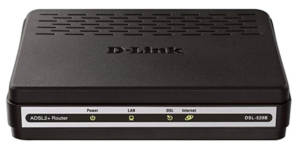
Centurylink has a list of modems that it has tested and that it says will work with its service. They are all expensive. And they are large — they take up a lot of space. You can find the D-Link DSL-520B modem brand new for an inexpensive price of about $35 and it is much smaller in size. Wouldn’t it be nice if you could use that modem with your Centurylink DSL service? This article describes how to configure that modem so that it will work with your Centurylink DSL service.
You will need to talk with Centurylink tech support to obtain four secret things:
- The VPI (virtual path identifier) which is a number between 0 and 255
- The VCI (virtual channel identifier) which is a number between 32 and 65535
- The PPPoE (point-to-point-protocol over ethernet) username
- The PPPoE (point-to-point-protocol over ethernet) password
You will need to connect a computer to the modem, using an ethernet cable. The computer should receive an IP address from the modem. (If it does not receive an IP address, then you might need to do a factory reset on the modem.) Log in at https://192.168.1.1. The default user name is “admin” and the default password is “admin”.
Click on “advanced setup” and “WAN”. Set the VPI and VCI. The service category should be the default which is UBR without PCR. The “enable quality of service” choice should be unchecked. Click “next”.
The connection type should be “PPP over Ethernet”. The encapsulation mode should be “LLC/SNAP-BRIDGING”. Click “next”.
Enter the PPP username and PPP password. You can enter a PPPoE service name but it does not matter. The authentication method can be the default which is “auto”. “Dial on demand” can be the default which is unchecked.
Now you face a choice:
- Modem only. Maybe you want the DSL-520B to be only a modem. This means you want the modem to be only in “bridge mode”. This means that the modem passes the routable IP address from Centurylink to the LAN port.
- Modem and router. The other possibility is that you want the DSL-520B to be both a modem and a router. In this mode, the DSL-520B provides a DHCP server and NAT and it provides a large number of non-routable IP addresses at the LAN port.
For “modem only” you should check “PPP IP extension”. For “modem and router” you should uncheck “PPP IP extension”.
You are almost certainly receiving a dynamic IP address from Centurylink, in which case you would not check “use static IP address”. Check that box only if you have made arrangements with Centurylink to receive a static IP address.
You could check “retry PPP password on authentication error” if you like. This should not be necessary because you should know your password. “Enable PPP debug mode” probably should be unchecked unless for some reason you feel the need to debug a PPP login problem.
Nearly all of the default settings in the DSL-520B work with Centurylink, but the single most important thing that you need to change is that “Bridge PPPoE Frames Between WAN and Local Ports” needs to be checked.
The MTU should be the default of 1492. Click “next”.
If you picked “modem and router” then on the next page you will have an opportunity to decide whether you want NAT (presumably you will want NAT) and whether you want firewall (presumably you will want firewall). Probably you will not want IGMP multicast. You must enable WAN service. The service name does not matter; you can enter whatever you wish into this field. Click “next”.
Now you will see a screen “WAN setup – summary”. Unless you made some mistake on one of the previous screens, then the information on this screen will be correct. Click “save”. On the next screen, click “save and reboot”.
Now you get to watch the LEDs. The Power LED will be red for a little while, and then will turn steady green. The DSL LED will blink green and then (hopefully) will turn steady green. The really good news will be when the Internet LED turns steady green, which means that the PPPoE login worked. Then it will flicker as data passes back and forth over the DSL connection.
